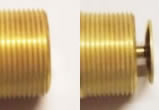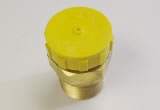Propane Fill Valve

When propane is delivered to a tank, the delivery driver hooks up the hose from the truck to the propane fill valve. The hose end coupling is screwed onto the filler valve and seated firmly against a gasket to prevent gas from escaping during the delivery process. If this gasket is not present in the fill valve, the connection between the hose and tank will not be secure and the delivery driver will not be able to fuel the propane tank. This black gasket is visible around the edge of the filler valve wall.
Propane Fill Valve Operation

After the hose coupling is securely attached to the tank fill valve, the valve is hose-end valve is opened and liquid propane begins to flow into the tank. The pressure from the gas in the hose alone is enough to open the fill valve. The figure to the left illustrates the open and closed positions of the filler valve when in use. This is located inside the tank and is not visible when looking at a propane tank. The part that is outside the tank also has a one-way valve that opens and closes with the pressure of the hose. This valve is visible by looking into the valve outside the tank. These two "back flow prevention" valves ensure that propane is securely stored in the tank opened only when a delivery is made.
Tank Fill Valve Protection

The protection of the filler valve is very important as it operates as the first line of supply to your gas system. The purpose of the protective cap is to keep water and debris from entering the valve. If debris enters the valve, it could keep the discs from seating properly causing the valve to remain in an open position allowing gas to escape. Water in the valve can cause the hose end coupling to be frozen onto the filler valve making it difficult for the delivery driver to disconnect the propane delivery hose from the fill valve.
